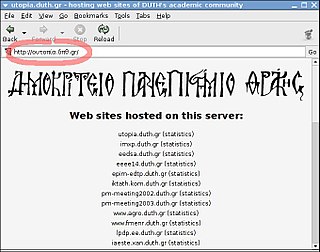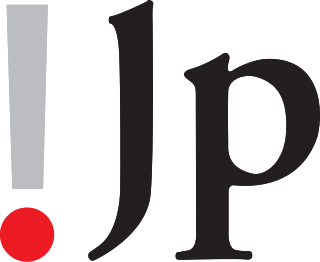External links
Website management | |||||
|---|---|---|---|---|---|
| Concepts |
| ||||
| Web hosting control panels (comparison) | |||||
| Top-level domain registries | |||||
| Domain name managers and registrars | |||||
| Web content management system | |||||
| International | |
|---|---|
| National | |
| Industry | domain name registration |
|---|---|
| Founded | December 26, 2000 |
| Headquarters | |
Area served | Worldwide |
| Owner | Ministry of Internal Affairs and Communications |
| Website | jprs |
The Japan Registry Services Co., Ltd. (JPRS) was incorporated on December 26, 2000. The organization under the Japan Ministry of Internal Affairs and Communications manages the .jp ccTLD, including the operation Minister of Internal Affairs and Communications of the registry and DNS servers.
JPRS came into existence out of a resolution at the 11th General Meeting of JPNIC, who had until then been managing the .jp domain. It was decided that due to the growing importance and complexity of the .jp domain, a separate corporation should be created with the purpose of running the registry.
In the period following the resolution, details were worked out, a structure was set up, and then on 2003-06-30, JPNIC, in co-operation with ICANN, transitioned the .jp domain to JPRS.
JPRS is the registry for the .jp domain. In this capacity, they are responsible for the administration and operation of the .jp domain, interacting with the public through private registrars of record.
JPRS is also a participant in the internationalized domain names (IDN) effort, which seeks to allow non-ASCII characters to be used in domain names. JPRS supports Internationalizing Domain Names in Applications (IDNA) which is a system by which Japanese characters can be converted into an ASCII representation of those characters, allowing Japanese characters to be used in applications without the underlying DNS being altered.
The Domain Name System (DNS) is a hierarchical and distributed name service that provides a naming system for computers, services, and other resources on the Internet or other Internet Protocol (IP) networks. It associates various information with domain names assigned to each of the associated entities. Most prominently, it translates readily memorized domain names to the numerical IP addresses needed for locating and identifying computer services and devices with the underlying network protocols. The Domain Name System has been an essential component of the functionality of the Internet since 1985.
A top-level domain (TLD) is one of the domains at the highest level in the hierarchical Domain Name System of the Internet after the root domain. The top-level domain names are installed in the root zone of the name space. For all domains in lower levels, it is the last part of the domain name, that is, the last non-empty label of a fully qualified domain name. For example, in the domain name www.example.com, the top-level domain is .com. Responsibility for management of most top-level domains is delegated to specific organizations by the ICANN, an Internet multi-stakeholder community, which operates the Internet Assigned Numbers Authority (IANA), and is in charge of maintaining the DNS root zone.

In the Internet, a domain name is a string that identifies a realm of administrative autonomy, authority or control. Domain names are often used to identify services provided through the Internet, such as websites, email services and more. Domain names are used in various networking contexts and for application-specific naming and addressing purposes. In general, a domain name identifies a network domain or an Internet Protocol (IP) resource, such as a personal computer used to access the Internet, or a server computer.
A domain name registry is a database of all domain names and the associated registrant information in the top level domains of the Domain Name System (DNS) of the Internet that enables third party entities to request administrative control of a domain name. Most registries operate on the top-level and second-level of the DNS.

The domain name .org is a generic top-level domain (gTLD) of the Domain Name System (DNS) used on the Internet. The name is truncated from 'organization'. It was one of the original domains established in 1985, and has been operated by the Public Interest Registry since 2003. The domain was originally "intended as the miscellaneous TLD for organizations that didn't fit anywhere else." It is commonly used by non-profit organizations, open-source projects, and communities, but is an open domain that can be used by anyone. The number of registered domains in .org has increased from fewer than one million in the 1990s, to ten million in 2012, and held steady between ten and eleven million since then.
An email address identifies an email box to which messages are delivered. While early messaging systems used a variety of formats for addressing, today, email addresses follow a set of specific rules originally standardized by the Internet Engineering Task Force (IETF) in the 1980s, and updated by RFC 5322 and 6854. The term email address in this article refers to just the addr-spec in Section 3.4 of RFC 5322. The RFC defines address more broadly as either a mailbox or group. A mailbox value can be either a name-addr, which contains a display-name and addr-spec, or the more common addr-spec alone.
Punycode is a representation of Unicode with the limited ASCII character subset used for Internet hostnames. Using Punycode, host names containing Unicode characters are transcoded to a subset of ASCII consisting of letters, digits, and hyphens, which is called the letter–digit–hyphen (LDH) subset. For example, München is encoded as Mnchen-3ya.

An internationalized domain name (IDN) is an Internet domain name that contains at least one label displayed in software applications, in whole or in part, in non-Latin script or alphabet or in the Latin alphabet-based characters with diacritics or ligatures. These writing systems are encoded by computers in multibyte Unicode. Internationalized domain names are stored in the Domain Name System (DNS) as ASCII strings using Punycode transcription.
In computer networking, a hostname is a label that is assigned to a device connected to a computer network and that is used to identify the device in various forms of electronic communication, such as the World Wide Web. Hostnames may be simple names consisting of a single word or phrase, or they may be structured. Each hostname usually has at least one numeric network address associated with it for routing packets for performance and other reasons.
A country code top-level domain (ccTLD) is an Internet top-level domain generally used or reserved for a country, sovereign state, or dependent territory identified with a country code. All ASCII ccTLD identifiers are two letters long, and all two-letter top-level domains are ccTLDs.

.ae is the country code top-level domain (ccTLD) in the Domain Name System of the Internet for the United Arab Emirates. It is administered by .aeDA which is part of the Telecommunications and Digital Government Regulatory Authority of UAE (TDRA).

.jp is the Internet country code top-level domain (ccTLD) for Japan. It was established in 1986 and is administered by the Japan Registry Services.

.tw is the Internet country code top-level domain (ccTLD) for Taiwan. The domain name is based on the ISO 3166-1 alpha-2 country code TW. The registry is maintained by the Taiwan Network Information Center (TWNIC), a Taiwanese non-profit organization appointed by the National Communications Commission (NCC) and the Ministry of Transportation and Communication. Since 1 March 2001, TWNIC has stopped allowing itself to sign up new domain names directly, instead allowing new registration through its contracted reseller registrars. As of May 2023, there are 17 registrars.
The Internationalized Resource Identifier (IRI) is an internet protocol standard which builds on the Uniform Resource Identifier (URI) protocol by greatly expanding the set of permitted characters. It was defined by the Internet Engineering Task Force (IETF) in 2005 in RFC 3987. While URIs are limited to a subset of the US-ASCII character set, IRIs may additionally contain most characters from the Universal Character Set, including Chinese, Japanese, Korean, and Cyrillic characters.
International email arises from the combined provision of internationalized domain names (IDN) and email address internationalization (EAI). The result is email that contains international characters, encoded as UTF-8, in the email header and in supporting mail transfer protocols. The most significant aspect of this is the allowance of email addresses in most of the world's writing systems, at both interface and transport levels.
DNS hijacking, DNS poisoning, or DNS redirection is the practice of subverting the resolution of Domain Name System (DNS) queries. This can be achieved by malware that overrides a computer's TCP/IP configuration to point at a rogue DNS server under the control of an attacker, or through modifying the behaviour of a trusted DNS server so that it does not comply with internet standards.
An internationalized country code top-level domain is a top-level domain in the Domain Name System (DNS) of the Internet. IDN ccTLDs are specially encoded domain names that are displayed in an end user application, such as a web browser, in their language-native script or alphabet, such as the Arabic alphabet, or a non-alphabetic writing system, such as Chinese characters. IDN ccTLDs are an application of the internationalized domain name system to top-level Internet domains assigned to countries, or independent geographic regions.
An Extensible Resource Identifier (XRI) is a scheme and resolution protocol for abstract identifiers compatible with Uniform Resource Identifiers (URI) and Internationalized Resource Identifiers (IRI), developed by the XRI Technical Committee at OASIS. The goal of XRI was a standard syntax and discovery format for abstract, structured identifiers that are domain-, location-, application-, and transport-independent, so they can be shared across any number of domains, directories, and interaction protocols.

.top is a generic top-level domain, officially delegated in ICANN's new gTLD program on August 4, 2014.